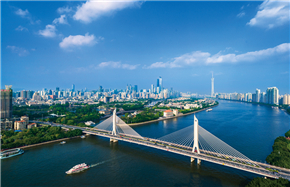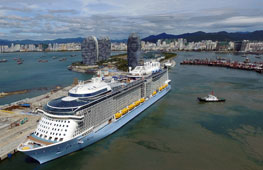Southern coastal sister cities unite to share wealth, convenience
The reforms and innovations of Shenzhen Customs are pushing the convenience of trade to new heights and boosting the Hong Kong special administrative region's ties to the Chinese mainland after the city's return to China in 1997.
Shenzhen, a coastal city in South China's Guangdong province, is the key trade hub between the mainland and the SAR.
Looking to the two areas' glorious past, statistics indicate that from 1997 to 2016, the total trade volume between Shenzhen and Hong Kong surged from 70.14 billion yuan ($10.26 billion) to 696.15 billion yuan, with an annual growth rate of up to 12.8 percent.
The annual growth rate averages 10.1 percentage points higher than that of the five years ahead of the homecoming year (1992-96).
Over the 20 years, the trade volume between the two cities has grown by nearly 10 times.
The rapid rise in trade volume provides ever escalating demands for customs services.
Shenzhen Customs, which offers land and sea port services, has remained committed to reforms and innovation in a bid to enhance its efficiency.
Currently, it is the only Customs office to open land port cargo transportation and 24-hour traveler check services in China.
It has taken the lead in the country to provide automatic examination services in its road port. The rapid clearance services between Shenzhen and Hong Kong have driven the region's customs services to a new level.
To date, its experiences have benefited not only the whole of Guangdong province, but also four provinces in the Pan-Pearl River Delta region, as well as the whole country.
Shenzhen Customs is not merely a witness of the great trade between Hong Kong and Shenzhen, but also a crucial participant.
The enhanced ties have also boosted Shenzhen Customs' business growth and reform, which has in turn accelerated local clearance businesses' efficiency and convenience.
Win-win era
Hong Kong's economy has been affected by the Asian financial crisis and global financial crunch over the past 20 years.
Despite these difficulties, Shenzhen's trade with Hong Kong has continued to account for a high proportion of Shenzhen's trade volume.
According to Liu Ying, a statistics official at Shenzhen Customs, the city's current trade with Hong Kong has entered an adjustment period, yet still ranks No 1 in terms of overall volume.
Last year, Shenzhen’s trade with the special administrative accounted for 20 percent of the city's trade volume.
Fresh vegetables, live ducks and chickens, fruits from around the world and novelty electronics flow smoothly between the two cities across the sea.
In the past 20 years, the trade structure has made tremendous changes from labor-intensive products to high-end electronic machinery and from processing trade to higher-level trade products.
Benefiting from mainland’s rising levels in the manufacturing industry, enterprises' independent management and consumers' spending habits, Shenzhen's trade with Hong Kong has been kicked into high gear.
The bonded zone areas in Shenzhen have seen their infrastructure and logistics services continue to optimize.
This has happened concurrently with a downward trend in Hong Kong's manufacturing sector, which previously located their factories in Shenzhen, and overseas companies' moves to locate their manufacturing centers elsewhere on the mainland.
As a result, Shenzhen's manufacturing sector saw a major drop.
However, the loss was offset by the growing private businesses from the mainland.
They have become another driving force behind trade, with annual growth of 44.3 percent, she said.
They now make up 40 percent of the city's total trade volume, compared with the figure of less than 1 percent in 1997.
The improved trade structure reflects a win-win era through mutually-beneficial and complementary trade between the Chinese mainland and Hong Kong.
Over the 20 years, three new ports have been set up, including the ports of Shenzhen Bay, Dachan Bay and Futian.
Among them, Shenzhen Bay was the country's first to launch simultaneous checks for both entry and exit, a starting point for Shenzhen and Hong Kong to strengthen regional collaboration and inject a new vigor into both sides.
Efficient clearance
In 2003, the Closer Economic Partnership Arrangement was singed between Hong Kong and the Chinese mainland.
In January of 2003, Huanggang port in Shenzhen began to offer 24-hour traveler checks and took the lead in China in offering cargo and passenger transport services day and night.
All of these have significantly benefited cargo to be shipped overseas via Shenzhen, including mobile phones, computers and other electronics.
Liu said: "Hong Kong's return to China has helped to optimize commodities' structure in trade and as a result, the sale of electronic goods is on the rise."
Shenzhen's labor-intensive products sold to Hong Kong have seen a major drop from an annual 28.5 percent in 1997 to just 5.4 percent in 2016.
The city's shipment of machinery electronics rose to 84.9 percent in 2016 from 35.8 percent in 1997, playing a key role among all varieties of products in trade.
In a bid to meet the growing demand of the new trade structure, Shenzhen Customs has beefed up its efforts to enhance its clearance efficiency.
A so-called Shenzhen speed has taken shape. In 2002, the Customs office began to offer automatic examination services in major road ports along the Guangdong-Hong Kong Road, reducing the average time for each bus from 5 seconds to 2 seconds.
In 2007, a cross-regional rapid clearance service was launched, offering seamless service along roads from Shenzhen to Hong Kong. The Hong Kong Customs office has begun its own multi-model cargo transportation plan and the mainland's Customs has begun to offer its cross-regional rapid clearance plan, which reduced the average clearance time by about 26 minutes.
The experience has been introduced throughout China since 2014. The Shenzhen Customs office has accumulated mature experience in cargo declaration, which has also been implemented throughout the whole province, the Pan-Pearl River Delta region as well as the whole country.
Food safety
Head of the Hong Kong-based Chao's Food Co Ltd, surnamed Peng, who has been engaged in the pig and duck business between Shenzhen and Hong Kong for more than 30 years, said his company has cultivated fields in Huizhou, Haifeng in Guangdong and Bobai in the Guangxi Zhuang autonomous region to provide livestock to Hong Kong every day.
"Since 1997, I could provide a list of goods and declare all varieties of goods ahead of time with the Customs office in Wenjindu port, which sped up our company's service to Hong Kong residents," he said.
Wenjindu has a long history of shipping livestock to Hong Kong, and almost 85 percent of vegetables and livestock come to the island via the port.
Statistics indicate that in 2016, the Customs office examined a total of 2.21 million tons of such products, up 3.2 percent year-on-year.
The total value hit $5.4 billion, up 9.5 percent year-on-year.
The service effectively fulfills Hong Kong residents' demand.
According to Shenzhen Customs, more than 1 million tons of fruit were imported from overseas through the city's ports to the Chinese mainland in 2016, up 10.1 percent year-on-year.
The value hit 15.19 billion yuan, more than any other port city in the country.
Wenjindu port is the country's No 1 port to import fruit from overseas in terms of volume and value.
The port has reduced red carpets in declaration, clearance and examination services and has been devoted itself to "zero retention" of fresh fruit and livestock.
"Five seconds for such trucks could be achieved through our automatic examination system," said Luo Chuanyong, a head of the logistics office in Wenjindu.
"The country's policies to support free trade guarantees our services. As part of recent 'green channel' measures, electronic and online systems deepen Shenzhen-Hong Kong trade ties," said Chen Shenghua, vice-director at the office of country of origin administration at Shenzhen Customs.
"In the past, overseas fruit needed two days to be transported from Hong Kong to the mainland, but now the electronic administrative online network has removed the barrier," he said.
Twin-city livelihood
According to statistics, in 1997, travelers across Luohu port, the key port between Hong Kong and Shenzhen, numbered 150,000 daily.
Nowadays, the figure has risen to 230,000, with a historical high of 398,000.
In August 2007, the opening of Futian port saw daily travelers reach 180,000.
Shenzhen has become home to many people working in Hong Kong. A twin-city lifestyle has taken shape.
Many Hong Kong residents start their businesses in Shenzhen while many Shenzhen residents seek job opportunities in Hong Kong.
Since 1999, an online traveler clearance system has been put into service and since 2000, risk management has been upgraded and backed by state-of-the-art technologies including body detectors and metal detectors.
Beginning in 2008, all luggage from travelers entering Shenzhen has been examined.
As many Shenzhen students study in Hong Kong, a special channel has been set up with stringent but convenient services to ensure their legality and safety.
Airport logistics
Shenzhen airport is now fostering a "four-hour airline circle" for the 21st Century Maritime Silk Road and a "12-hour airline circle" among many major global cities.
Prior to 1997, Shenzhen Bao'an International Airport seldom offered global air routs, with just a few linking the city to Southeast Asian destinations.
Nowadays it has become a huge international transport hub. In August 2005, an airline logistics fast lane between Hong Kong and Shenzhen's airports was inaugurated. Cargos from Hong Kong to Shenzhen airports now enjoy non-barrier clearance, significantly lowering pressure on transport, logistics and surveillance systems.
An international express mail examination center and airline logistics parks have been opened to serve both airports.
Statistics indicated that during the first five months of this year, the Shenzhen Airport handled 18.52 million travelers, up 8.8 percent year-on-year. Cargo throughput hit 449,000 tons, up 6.8 percent year-on-year.
Shenzhen's airport and customs services have also benefited from the country's Belt and Road Initiative.
To date, Shenzhen has risen to take the lead in China in terms of its high-tech prowess, enjoying an excellent investment and startup environment.
Its GDP rose to 2.6 percent of the nation's total.
Hong Kong stands firm as a global financial and logistics center with a strong human resources reserve. Despite the drop in its GDP proportion within China's overall volume, it still makes up 3 percent.
The kinship between the two cities is unparalleled in the country. Thanks to the neighbors' economic strengths, opening-up and exceptional legal governance, the complementary pair seems unbeatable.Looking forward, a new chapter for trade is still yet to unfold thanks to Shenzhen Customs' commitment to innovation and reform.
zhuanti@chinadaily.com.cn














